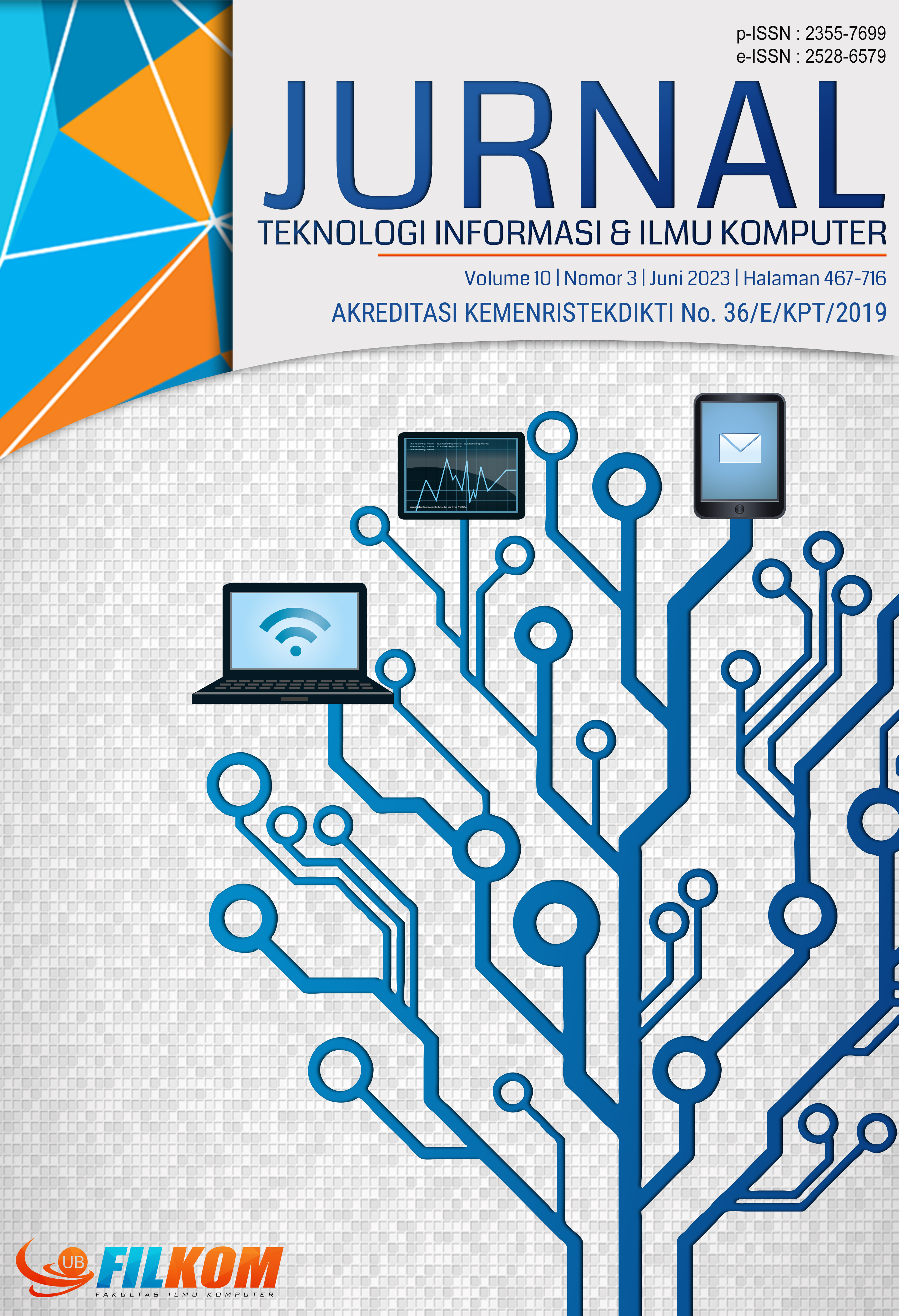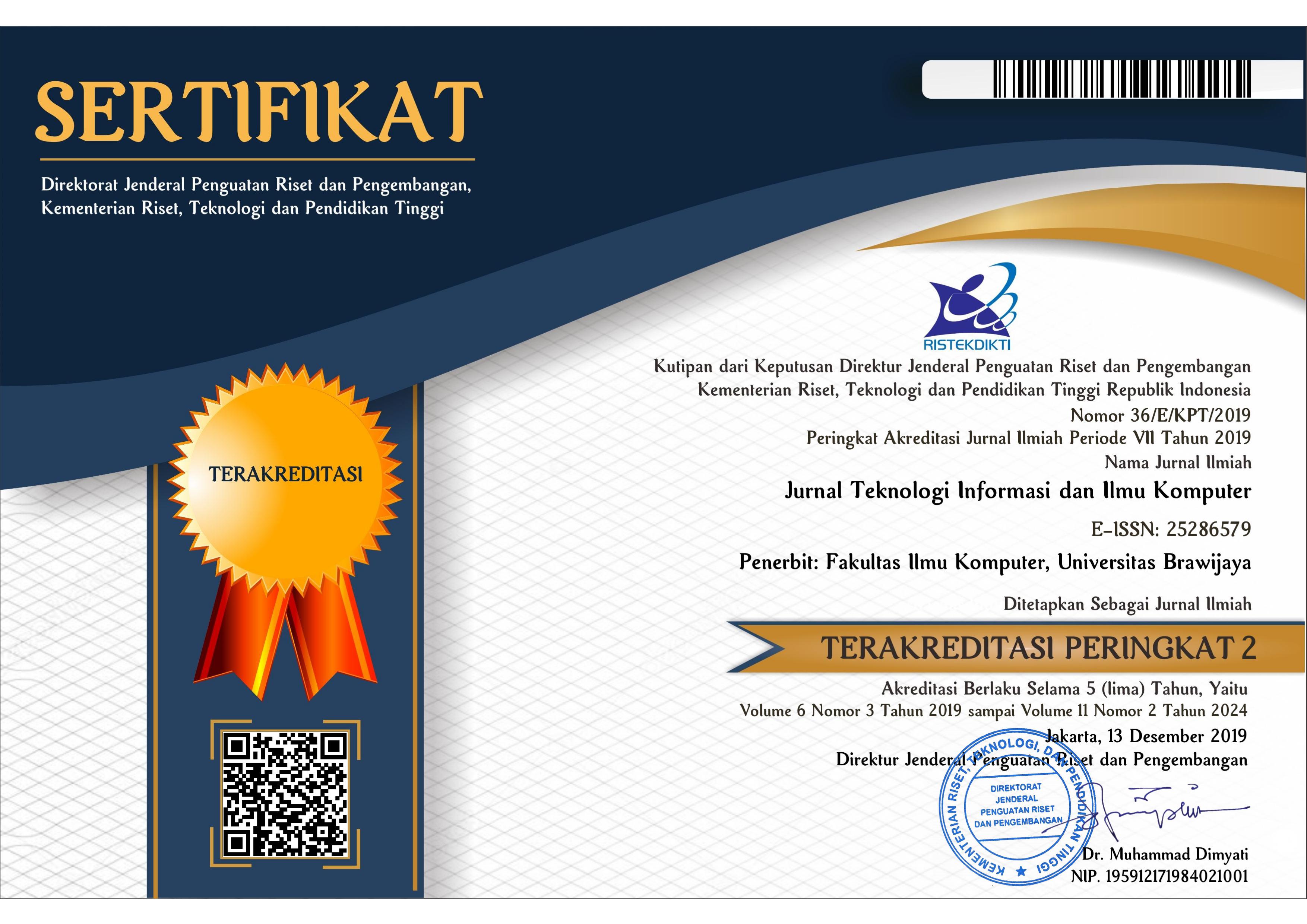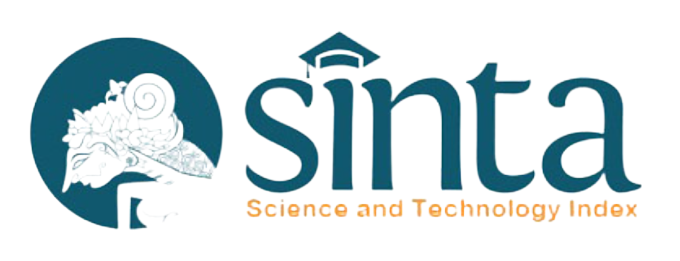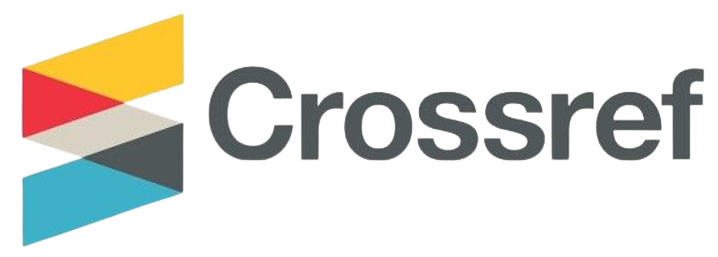CHEST X-RAY IMAGE SEGMENTATION USING MODIFIED DEEPLABV3+ METHOD
DOI:
https://doi.org/10.25126/jtiik.2023106754Abstrak
COVID-19 is a disease that affects the human respiratory system. The latest developments in September 2022 the number of confirmed cases of COVID-19 worldwide reached 608,328,548 with 6,501,469 patients who died. While in Indonesia confirmed COVID-19 reached 6,408,806 with 157,892 patients who died. Reserve Transcription Polymerase Chain Reaction (RT-PCR) is the most widely used tool. However, the latest RT-PCR test report shows that the RT-PCR test is inadequate. As an alternative, radiographic images such as chest x-rays and CT scans can help detect this. Radiographic images, especially x-rays, need processing to be able to make a diagnosis. Computer Aided Diagnosis (CAD) is a computer assisted diagnosis system that can be used as supporting information in making a diagnosis. To make it easier to make a diagnosis, we need a deep learning model that can help with this. DeepLabV3+ is a method that can carry out the segmentation process. DeepLabV3+ which is an extension of DeepLabV3 with the aim of improving the segmentation results. DeepLabV3+ uses a modified Xception as the backbone. In this study, 1,500 chest x-ray image data were used which were then divided into 80% for training data and 20% for testing data. There are 4 test scenarios in this study, namely with a learning rate of 0.01 without CLAHE, a learning rate of 0,01 and using CLAHE, a learning rate of 0,0001 without CLAHE, and a learning rate of 0,0001 using CLAHE. Of the 4 scenarios the learning rate scenario is 0,01 and using CLAHE gets the highest evaluation results using the Dice Similarity Coefficient (DSC) of 96.91%.
Downloads
Referensi
BASO, B., & SUCIATI, N. 2020. Temu Kembali Citra Tenun Nusa Tenggara Timur menggunakan Esktraksi Fitur yang Robust terhadap Perubahan Skala, Rotasi, dan Pencahayaan. Jurnal Teknologi Informasi Dan Ilmu Komputer, 7(2), 349. https://doi.org/10.25126/jtiik.2020722002
CHEN, L.-C., PAPANDREOU, G., KOKKINOS, I., MURPHY, K., & YUILLE, A. L. 2014. Semantic Image Segmentation with Deep Convolutional Nets and Fully Connected CRFs. ArXiv, 40(4), 1–14.
https://doi.org/https://doi.org/10.48550/arXiv.1412.7062
CHEN, L.-C., PAPANDREOU, G., KOKKINOS, I., MURPHY, K., & YUILLE, A. L. 2018. DeepLab: Semantic Image Segmentation with Deep Convolutional Nets, Atrous Convolution, and Fully Connected CRFs.
IEEE Transactions on Pattern Analysis and Machine Intelligence, 40(4), 834–848. https://doi.org/10.1109/TPAMI.2017.2699184
CHEN, L.-C., PAPANDREOU, G., SCHROFF, F., & ADAM, H. 2017.
Rethinking Atrous Convolution for Semantic Image Segmentation. ArXiv. http://arxiv.org/abs/1706.05587
CHEN, L.-C., ZHU, Y., PAPANDREOU, G., SCHROFF, F., & ADAM, H. 2018. Encoder-decoder with atrous separable convolution for semantic image segmentation. Lecture Notes in Computer Science (Including Subseries Lecture Notes in Artificial Intelligence and Lecture Notes in Bioinformatics), 11211 LNCS, 833–851. https://doi.org/10.1007/978-3-030-01234-2_49
CHENG, J., TIAN, S., YU, L., LU, H., & LV, X. 2020. Fully convolutional attention network for biomedical image segmentation. Artificial Intelligence in Medicine, 107(June), 101899. https://doi.org/10.1016/j.artmed.2020.101899
EL-BANA, S., AL-KABBANY, A., & SHARKAS, M. 2020. A multi-task pipeline with specialized streams for classification and segmentation of infection manifestations in COVID-19 scans. PeerJ Computer Science, 6, 1–27. https://doi.org/10.7717/peerj-cs.303
HASMA, Y. A., & SILFIANTI, W. 2018. Implementasi Deep Learning Menggunakan Framework Tensorflow Dengan Metode Faster Regional Convolutional Neural Network Untuk Pendeteksian Jerawat. Jurnal Ilmiah Teknologi Dan Rekayasa, 23(2), 89–102. https://doi.org/10.35760/tr.2018.v23i2.2459
KAUR, D., & KAUR, Y. (2014). Various Image Segmentation Techniques: A Review. International Journal of Computer Science and Mobile Computing, 3(5), 809–8014.
KHAN, Z., YAHYA, N., ALSAIH, K., ALI, S. S. A., & MERIAUDEAU, F. 2020. Evaluation of deep neural networks for semantic segmentation of prostate in T2W MRI. Sensors (Switzerland), 20(11), 1–17. https://doi.org/10.3390/s20113183
KUMASEH, M. R., LATUMAKULITA, L., & NAINGGOLAN, N. (2013). Segmentasi Citra Digital Ikan Menggunakan Metode Thresholding. Jurnal Ilmiah Sains, 13(1), 75–79. https://doi.org/10.35799/jis.17.2.2017.18128
MULLER, D., SOTO-REY, I., & KRAMER, F. 2020. Automated Chest CT Image Segmentation of COVID-19 Lung Infection based on 3D U-Net. ArXiv, abs/2007.0, 1–9.
NUGROHO, P. A., FENRIANA, I., & ARIJANTO, R. 2020. Implementasi Deep Learning Menggunakan Convolutional Neural Network ( CNN ) Pada Ekspresi Manusia. Algor, 2(1), 12–21.
ROTHAN, H. A., & BYRAREDDY, S. N. (2020). The epidemiology and pathogenesis of coronavirus disease (COVID-19) outbreak. Journal of Autoimmunity, 109(February), 102433. https://doi.org/10.1016/j.jaut.2020.102433
SAOOD, A., & HATEM, I. (2021). COVID-19 lung CT image segmentation using deep learning methods: U-Net versus SegNet. BMC Medical Imaging, 21(1), 1–10. https://doi.org/10.1186/s12880-020-00529-5
SHI, F., WANG, J., SHI, J., WU, Z., WANG, Q., TANG, Z., HE, K., SHI, Y., & SHEN, D. (2021). Review of Artificial Intelligence Techniques in Imaging Data Acquisition, Segmentation, and Diagnosis for COVID-19. IEEE Reviews in Biomedical Engineering, 14, 4–15. https://doi.org/10.1109/RBME.2020.2987975
SUSANTO, A. 2019. Penerapan Operasi Morfologi Matematika Citra Digital untuk Ekstraksi Area Plat Nomor Kendaraan Bermotor. Pseudocode, VI, 9.
SUSILO, A.,dkk. 2020. Coronavirus Disease 2019: Tinjauan Literatur Terkini. Jurnal Penyakit Dalam Indonesia, 7(1), 45–67. https://doi.org/10.25104/transla.v22i2.1682
WHO. 2022. COVID-19 Weekly Epidemiological Update. In World Health Organization (Issue February).
YAN, Q., WANG, B., GONG, D., LUO, C., ZHAO, W., SHEN, J., SHI, Q., JIN, S., ZHANG, L., & YOU, Z. 2020. COVID-19 Chest CT Image Segmentation - A Deep Convolutional Neural Network Solution. ArXiv, abs/2004.1, 1–10. http://arxiv.org/abs/2004.10987
YUDISTIRA, N., WIDODO, A. W., & RAHAYUDI, B. 2020. Deteksi Covid-19 pada Citra Sinar-X Dada Menggunakan Deep Learning yang Efisien. Jurnal Teknologi Informasi Dan Ilmu Komputer, 7(6), 1289. https://doi.org/10.25126/jtiik.2020763651
Unduhan
Diterbitkan
Terbitan
Bagian
Lisensi

Artikel ini berlisensi Creative Common Attribution-ShareAlike 4.0 International (CC BY-SA 4.0)
Penulis yang menerbitkan di jurnal ini menyetujui ketentuan berikut:
- Penulis menyimpan hak cipta dan memberikan jurnal hak penerbitan pertama naskah secara simultan dengan lisensi di bawah Creative Common Attribution-ShareAlike 4.0 International (CC BY-SA 4.0) yang mengizinkan orang lain untuk berbagi pekerjaan dengan sebuah pernyataan kepenulisan pekerjaan dan penerbitan awal di jurnal ini.
- Penulis bisa memasukkan ke dalam penyusunan kontraktual tambahan terpisah untuk distribusi non ekslusif versi kaya terbitan jurnal (contoh: mempostingnya ke repositori institusional atau menerbitkannya dalam sebuah buku), dengan pengakuan penerbitan awalnya di jurnal ini.
- Penulis diizinkan dan didorong untuk mem-posting karya mereka online (contoh: di repositori institusional atau di website mereka) sebelum dan selama proses penyerahan, karena dapat mengarahkan ke pertukaran produktif, seperti halnya sitiran yang lebih awal dan lebih hebat dari karya yang diterbitkan. (Lihat Efek Akses Terbuka).















